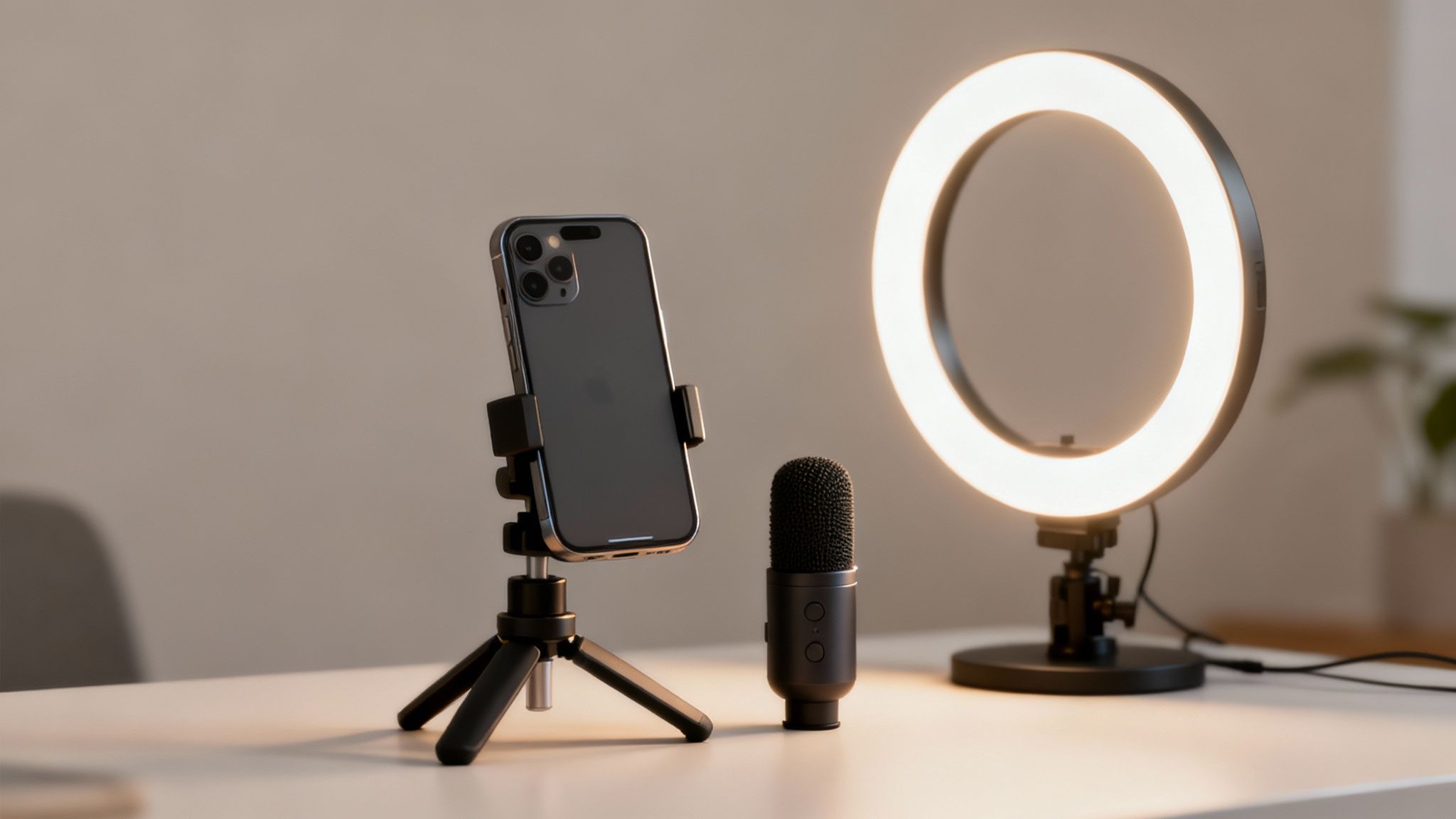In today’s crowded market, small businesses need a way to stand out, connect authentically, and build real trust. Video marketing isn’t a luxury for big brands anymore; it’s an essential, affordable tool that lets you tell your story, showcase your value, and turn viewers into loyal customers.
This guide is framed as a Q&A expert briefing, answering the most common questions small business owners have about using video to fuel their growth.

Why is video marketing for small business so effective compared to static ads?
Think of it this way: a static ad is a flyer, but a video is a conversation. Video captures attention in a way that text and images simply can’t. It combines motion, sound, and storytelling to create an emotional connection.
For a small business, this is a massive advantage. You can show the quality of your craft, demonstrate how your product solves a problem, and let customers see the passionate people behind the brand. This dynamic approach makes your marketing more memorable, builds trust faster, and helps you compete with larger players by showcasing your unique personality. While static ads inform, video engages and persuades. For more on this, explore our detailed guide on why you should use video for marketing.
What kinds of videos should small businesses start with?

Don’t try to do everything at once. Start with a few high-impact videos that address key business goals. Here are four excellent choices for beginners:
- Explainer Videos: Your digital elevator pitch. In 60-90 seconds, explain what your business does, the problem you solve, and what makes you unique. It’s perfect for your website’s homepage to quickly clarify your value to new visitors.
- Product/Service Demos: Show, don’t just tell. A demo video walks potential customers through how your product or service works in a real-world scenario. This builds confidence and answers questions before they’re even asked, pushing them closer to a purchase.
- Customer Testimonials: Let your happy customers do the selling for you. A short video of a real person sharing their positive experience is incredibly persuasive. It provides powerful social proof that feels more authentic than any sales copy you could write.
- Social Media Videos (Reels/Shorts/TikToks): These short, engaging clips are perfect for showing your brand’s personality. Think behind-the-scenes glimpses, quick tips, or before-and-after reveals. They are designed to stop the scroll, build community, and keep your business top-of-mind.
How can small businesses create engaging videos on a limited budget?

Great video is no longer about a big budget; it’s about being creative and authentic. You already have the most important tool in your pocket.
- Use Your Smartphone: Modern phone cameras are incredibly powerful. With a small tripod to keep shots steady and good natural lighting from a window, you can shoot professional-looking footage.
- Prioritize Clear Audio: Viewers will forgive imperfect video quality, but they won’t tolerate bad sound. An inexpensive lavalier microphone (a clip-on mic) that plugs into your phone is the single best investment you can make, ensuring your message is heard clearly.
- Plan with a Simple Script: You don’t need a Hollywood screenplay. A simple outline with a hook, your main points, and a clear call-to-action will keep your video focused and prevent rambling.
- Focus on Story, Not Sales: The most engaging videos tell a story. Instead of a hard sell, share your passion, solve a customer’s problem, or showcase a success story. Authenticity connects far better than slick production.
For more practical tips, check out our guide on how to create a promo video for your business on a budget.
What platforms are best for distributing video content?

Don’t try to be everywhere. Focus on the platforms where your target customers spend their time.
- YouTube: Best for searchable, “how-to” content. Think of it as a video search engine. In-depth tutorials, product demos, and explainer videos live well here because people go to YouTube to find answers and learn.
- Instagram & TikTok: Ideal for short, personality-driven videos that grab attention quickly. Use these platforms for behind-the-scenes content, quick tips, and trending formats to build brand awareness and engage a younger audience.
- Facebook: Excellent for building community, especially for local businesses. Share customer testimonials, company news, and run live Q&A sessions to foster a loyal following.
- LinkedIn: The top choice for B2B businesses. Share industry insights, company culture videos, and case studies to establish your expertise and connect with other professionals.
Organizing your video files is also key. Learn more about Digital Asset Management for Video to keep your content library manageable. For a deeper dive on platforms, see our guide on where to host your explainer videos.
How short or long should a video be to maximize attention?
The golden rule is: be as long as you need to be to deliver value, and not one second longer. The ideal length depends entirely on the platform and the video’s purpose.
- Under 60 seconds (ideally 15-45 seconds): For social media platforms like TikTok, Instagram Reels, and YouTube Shorts. Your goal is to stop the scroll and deliver a quick, entertaining, or informative punch.
- 1-2 minutes: Perfect for explainer videos or product demos on your website. This is enough time to explain your value proposition clearly without losing the viewer’s interest.
- 2-5 minutes: Suited for in-depth tutorials or how-to guides on YouTube. Viewers on this platform are often in a learning mindset and are willing to invest more time in content that solves a specific problem for them.
Always lead with your hook in the first 3-5 seconds to capture attention immediately. For more platform-specific timing, this guide on What is the Best Video Length for Your Reels, TikToks and Shorts is a great resource.
How can video help humanize a small business and build stronger local connections?
Video is the ultimate tool for putting a face to your brand. When customers see the real people behind a business, it breaks down corporate barriers and builds genuine human connection. This is a superpower for small businesses.
Use video to:
- Share your founder’s story: Why did you start this business? People connect with passion and purpose.
- Introduce your team: A quick “meet the team” video makes your business feel more approachable and friendly.
- Show behind-the-scenes footage: Give a tour of your workshop, store, or office. This transparency builds trust and makes customers feel like insiders.
When local customers see you and your team as neighbors, not just a nameless storefront, they are far more likely to support you, trust you, and become loyal advocates for your brand.
What are the biggest mistakes small businesses make when starting with video?
Avoiding a few common pitfalls can make all the difference. Here are the top three:
- Ignoring Audio Quality: This is the cardinal sin of video. You can have a stunning picture, but if the audio is muffled or full of background noise, people will immediately click away. A simple, affordable microphone is a non-negotiable investment.
- Selling Instead of Storytelling: Don’t just make video advertisements. People connect with stories, not sales pitches. Focus on helping, educating, or entertaining your audience. Show how you solve a problem rather than just listing product features.
- Forgetting the Call-to-Action (CTA): Every video needs a purpose. What do you want the viewer to do next? Whether it’s “visit our website,” “follow us for more tips,” or “shop the link in bio,” a clear CTA turns a passive view into a meaningful business action.
Running out of inspiration is also common. When you feel stuck, browsing a collection of video ideas can spark new creativity. And as you grow, maintaining consistent video production can become challenging. A video automation solution can help you scale your efforts efficiently, creating personalized content without draining your resources.
Ready to make video marketing your small business superpower? Wideo gives you user-friendly tools to create professional animated videos and presentations in minutes. Start creating with Wideo today!






